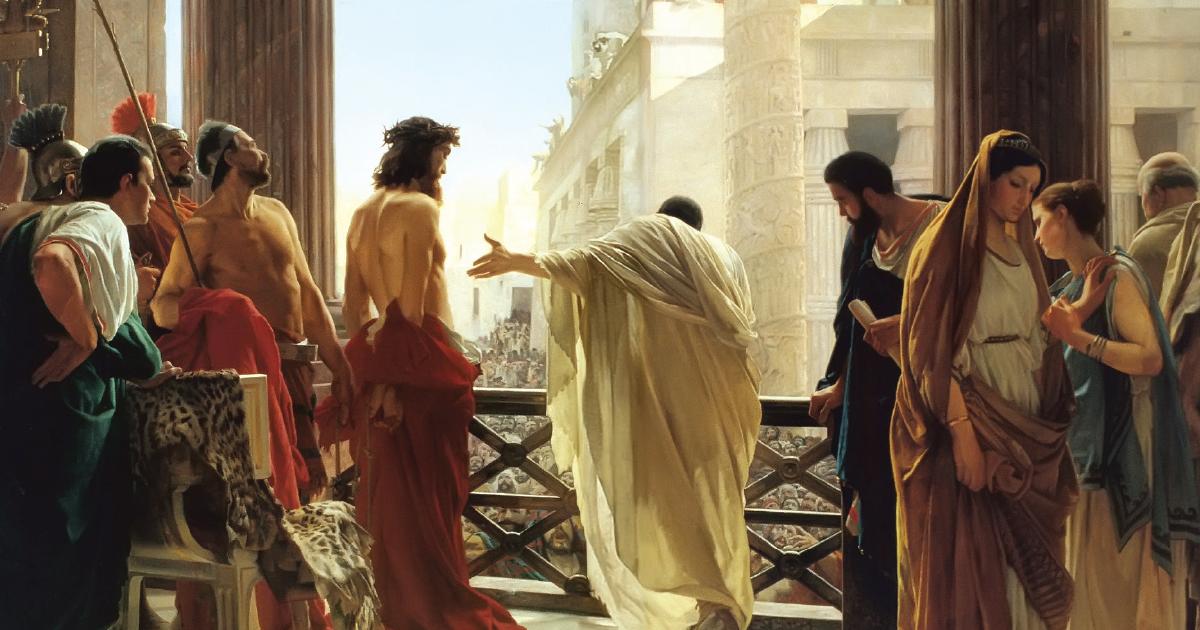Who is the most successful trial attorney in the world?
According to the Guinness Book of World Records, the answer is Sir Lionel Luckhoo, who succeeded in getting his 245th consecutive murder acquittal by January 1, 1985. He was called the real-life Perry Mason.
What skills accounted for such courtroom success?
With his tremendous analytical skills, he could consider an airtight prosecution case and spot the flaws. He was an expert as to what constitutes reliable, admissible and persuasive evidence.
So how would Sir Lionel have viewed the evidence for the Resurrection of Jesus Christ?
Well, he took his expertise in law and actually questioned whether it stood up to the tests of legal evidence.
“I say unequivocally that the evidence for the Resurrection of Jesus is so overwhelming,” he concluded, “it compels acceptance by proof that leaves absolutely no room for doubt.”
Sir Lionel then decided to do the most logical thing in the world. He became a Christian.
Death by Flogging
The Apostle Paul writes, “And if Christ has not been raised, your faith is futile; you are still in your sins” (1 Corinthians 15:17).
What he is saying is if this is make-believe, if this is legend, faith is worthless. The Resurrection of Jesus is the linchpin of Christianity.
Some people take the position that Jesus never really died on the cross. The “swoon theory” says that Jesus either fainted on the cross or took some sort of a drug to make it appear as if He had died. When He was taken to the tomb, cool air revived Him and He emerged alive.
The Bible states that after Jesus was put on trial by Pontius Pilate, who was the Roman official in charge of the province of Judea, “Then Pilate took Jesus and had Him flogged” (John 19:1).
Medical expert C. Truman Davis studied what was involved with flogging. He concluded that it was a very brutal beating that left Jesus at the very edge of death. Many who were sentenced to death by crucifixion never made it to the cross alive due to this beating.
Death by Crucifixion
Crucifixion caused a slow death by suffocation. If the Romans wanted to hasten death, they would shatter the victim’s shins with a mallet. They did this to the criminals who were crucified with Jesus, but they didn’t do that to Jesus because it was clear that He was already dead.
“Instead,” as John, one of Jesus’ closest disciples and an eyewitness to the crucifixion, reported, “one of the soldiers pierced Jesus’ side with a spear, bringing a sudden flow of blood and water” (John 19:34).
Nobody left the Roman cross alive. That included Jesus.
An authoritative article in the prestigious Journal of the American Medical Society concluded, “Clearly the weight of the historical and medical evidence is that Jesus was dead before the wound to His side was inflicted and supports the traditional view that the spear probably perforated not only the right lung but also the pericardium and heart and thereby ensured His death. Accordingly, interpretations based upon the assumption that Jesus did not die on the cross appear to be at odds with modern medical knowledge.”
Now, let’s consider the affirmative evidence for the Resurrection of Jesus.
Truth or Mythology?
The accounts of Jesus being the Son of God began very early, before any mythology could have contaminated the accounts.
Studies of the rate at which legends accrued in the ancient world tell us it takes a minimum of two generations for mythology to corrupt a solid core of historical fact. The creed recited by the early church said, “Jesus died for our sins according to the Scriptures. He was buried and He was raised on the third day according to the Scriptures.”
This creed dates back to as early as 23 to 36 months after Jesus was crucified. This contradicts the assertion that the Resurrection was a product of mythology about the life of Jesus.
The Logical Thing
His tomb was empty, and no one to this day has uncovered the body of Jesus. History tells us that His body was laid to rest in a tomb belonging to Joseph of Arimathea, a prominent member of the Jewish council. An extremely heavy boulder was rolled in front of it with the seal of Rome placed on it, then guarded by elite Roman soldiers. Yet it was discovered empty on Easter morning.
So here is the single most important fact about the tomb of Jesus: No one ever claimed that it was anything but empty. Even His opponents admitted His tomb was empty. They bribed the guards to say, “The disciples stole the body while they were asleep.”
During the 40 days after His Resurrection, Jesus appeared a dozen times to more than 500 different individuals. He appeared to men and women. He appeared to believers and skeptics. He appeared to both tough-minded and tender-hearted people. He appeared sometimes to individuals, sometimes to small groups and sometimes to large groups. He talked with people. He ate with people.
Jesus told the truth when He said, “I am the Resurrection and the life. The one who believes in Me will live, even though they die” (John 11:25).
Why did He endure the cross, the beating, the humiliation? It was out of His love for us. When we accept what Jesus did on the cross, when we accept Jesus as the forgiver of sin, we can have confidence that we, too, like Jesus, will someday overcome the grave and spend eternity with Jesus in heaven.
So, this Easter, let’s do what Sir Lionel did. Check out the evidence for ourselves. Investigate it. Make up our minds to explore the claims about this most wonderful truth.
Then, perhaps, like Sir Lionel did, we will also decide to do the most logical thing in the world.
Reprinted from The War Cry (United States), Easter 2014
This story is from:
According to the Guinness Book of World Records, the answer is Sir Lionel Luckhoo, who succeeded in getting his 245th consecutive murder acquittal by January 1, 1985. He was called the real-life Perry Mason.
What skills accounted for such courtroom success?
With his tremendous analytical skills, he could consider an airtight prosecution case and spot the flaws. He was an expert as to what constitutes reliable, admissible and persuasive evidence.
So how would Sir Lionel have viewed the evidence for the Resurrection of Jesus Christ?
Well, he took his expertise in law and actually questioned whether it stood up to the tests of legal evidence.
“I say unequivocally that the evidence for the Resurrection of Jesus is so overwhelming,” he concluded, “it compels acceptance by proof that leaves absolutely no room for doubt.”
Sir Lionel then decided to do the most logical thing in the world. He became a Christian.
Death by Flogging
The Apostle Paul writes, “And if Christ has not been raised, your faith is futile; you are still in your sins” (1 Corinthians 15:17).
What he is saying is if this is make-believe, if this is legend, faith is worthless. The Resurrection of Jesus is the linchpin of Christianity.
Some people take the position that Jesus never really died on the cross. The “swoon theory” says that Jesus either fainted on the cross or took some sort of a drug to make it appear as if He had died. When He was taken to the tomb, cool air revived Him and He emerged alive.
The Bible states that after Jesus was put on trial by Pontius Pilate, who was the Roman official in charge of the province of Judea, “Then Pilate took Jesus and had Him flogged” (John 19:1).
Medical expert C. Truman Davis studied what was involved with flogging. He concluded that it was a very brutal beating that left Jesus at the very edge of death. Many who were sentenced to death by crucifixion never made it to the cross alive due to this beating.
Death by Crucifixion
Crucifixion caused a slow death by suffocation. If the Romans wanted to hasten death, they would shatter the victim’s shins with a mallet. They did this to the criminals who were crucified with Jesus, but they didn’t do that to Jesus because it was clear that He was already dead.
“Instead,” as John, one of Jesus’ closest disciples and an eyewitness to the crucifixion, reported, “one of the soldiers pierced Jesus’ side with a spear, bringing a sudden flow of blood and water” (John 19:34).
Nobody left the Roman cross alive. That included Jesus.
An authoritative article in the prestigious Journal of the American Medical Society concluded, “Clearly the weight of the historical and medical evidence is that Jesus was dead before the wound to His side was inflicted and supports the traditional view that the spear probably perforated not only the right lung but also the pericardium and heart and thereby ensured His death. Accordingly, interpretations based upon the assumption that Jesus did not die on the cross appear to be at odds with modern medical knowledge.”
Now, let’s consider the affirmative evidence for the Resurrection of Jesus.
Truth or Mythology?
The accounts of Jesus being the Son of God began very early, before any mythology could have contaminated the accounts.
Studies of the rate at which legends accrued in the ancient world tell us it takes a minimum of two generations for mythology to corrupt a solid core of historical fact. The creed recited by the early church said, “Jesus died for our sins according to the Scriptures. He was buried and He was raised on the third day according to the Scriptures.”
This creed dates back to as early as 23 to 36 months after Jesus was crucified. This contradicts the assertion that the Resurrection was a product of mythology about the life of Jesus.
The Logical Thing
His tomb was empty, and no one to this day has uncovered the body of Jesus. History tells us that His body was laid to rest in a tomb belonging to Joseph of Arimathea, a prominent member of the Jewish council. An extremely heavy boulder was rolled in front of it with the seal of Rome placed on it, then guarded by elite Roman soldiers. Yet it was discovered empty on Easter morning.
So here is the single most important fact about the tomb of Jesus: No one ever claimed that it was anything but empty. Even His opponents admitted His tomb was empty. They bribed the guards to say, “The disciples stole the body while they were asleep.”
During the 40 days after His Resurrection, Jesus appeared a dozen times to more than 500 different individuals. He appeared to men and women. He appeared to believers and skeptics. He appeared to both tough-minded and tender-hearted people. He appeared sometimes to individuals, sometimes to small groups and sometimes to large groups. He talked with people. He ate with people.
Jesus told the truth when He said, “I am the Resurrection and the life. The one who believes in Me will live, even though they die” (John 11:25).
Why did He endure the cross, the beating, the humiliation? It was out of His love for us. When we accept what Jesus did on the cross, when we accept Jesus as the forgiver of sin, we can have confidence that we, too, like Jesus, will someday overcome the grave and spend eternity with Jesus in heaven.
So, this Easter, let’s do what Sir Lionel did. Check out the evidence for ourselves. Investigate it. Make up our minds to explore the claims about this most wonderful truth.
Then, perhaps, like Sir Lionel did, we will also decide to do the most logical thing in the world.
Reprinted from The War Cry (United States), Easter 2014
This story is from:








Leave a Comment